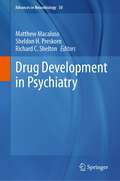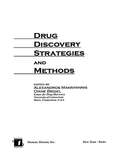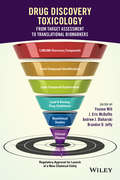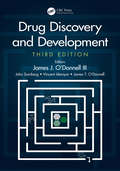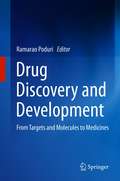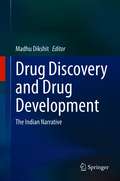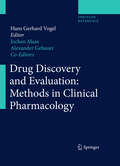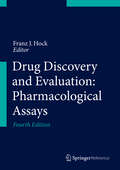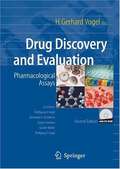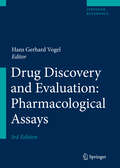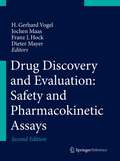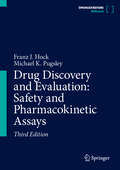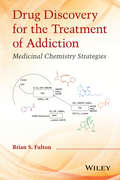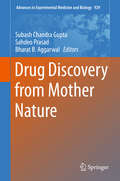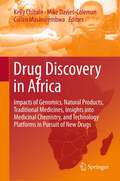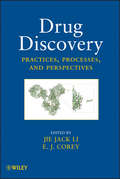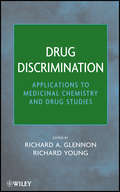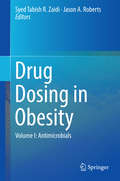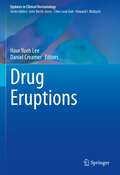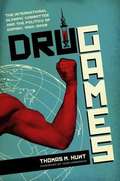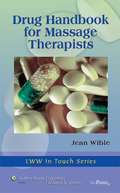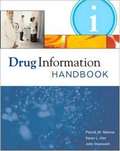- Table View
- List View
Drug Development in Psychiatry (Advances in Neurobiology #30)
by Matthew Macaluso Sheldon H. Preskorn Richard C. SheltonThe book reviews clinical trial methodology as it pertains to drug development in psychiatry. The reader will understand the process of drug development in psychiatry from discovery through marketing with the help of clinically relevant examples. The reader will appreciate the history of drug development in psychiatry dating back to the era of serendipitous discovery and culminating in an era of new and highly focused targets. Readers will understand how drug development in psychiatry has changed and adapted with the discovery of novel mechanism of action drugs. Novel drugs and disease targets have changed the way developers and regulatory agencies think about clinical trial methodology.The book elucidates how biomarkers, genetics and advances in neuroscience and neuroimaging have influenced drug development approaches, which will ultimately change the practice of psychiatry. The book will be broken down into the following sections:a. Prior to the 1960s - Drug discovery by chance observationb. The last 50 years – refined targeting of CNS drugs without the discovery of mechanistically new drugsc. The future – the discovery and development of mechanistically new drugs. The examination of new targets, genetics and biomarkers.
Drug Discovery Strategies and Methods
by Alexandros Makriyannis Diane BiegelNavigate the complex and multidisciplinary path of drug discovery procedures with Drug Discovery Strategies and Methods-a well-organized and timely reference that analyzes methods in target identification and validation, lead detection, compound optimization, and biological testing. This volume addresses challenges encountered during the discovery
Drug Discovery Toxicology: From Target Assessment to Translational Biomarkers
by Yvonne Will J. Eric Mcduffie Andrew J. Olaharski Brandon D. JeffyAs a guide for pharmaceutical professionals to the issues and practices of drug discovery toxicology, this book integrates and reviews the strategy and application of tools and methods at each step of the drug discovery process. * Guides researchers as to what drug safety experiments are both practical and useful* Covers a variety of key topics - safety lead optimization, in vitro-in vivo translation, organ toxicology, ADME, animal models, biomarkers, and -omics tools* Describes what experiments are possible and useful and offers a view into the future, indicating key areas to watch for new predictive methods* Features contributions from firsthand industry experience, giving readers insight into the strategy and execution of predictive toxicology practices
Drug Discovery and Design Using Natural Products
by Jorddy Neves CruzHistorically, natural products have great relevance for the development of new drugs. Natural molecules, in addition to directly providing new compounds with different therapeutic functions have provided scaffolds and a great diversity of structures that serve as inspiration for the design and discovery of new drugs. The great structural complexity and the significant number of natural compounds that can be obtained and their advantages also present some historical problems that need to be overcome. Issues such as difficulty in isolation, difficulty in synthesizing compounds found in nature in the laboratory, screening to evaluate the biological properties of these compounds, and structural optimization to enhance the pharmacological properties of biomolecules; are some of the main difficulties encountered in research with natural products and in the design/discovery of new medicines. Therefore, this book addresses the great scientific advances that provide practical solutions to using natural products to develop new drugs. We address topics related to the genesis of research projects that use natural products to design new drugs. We address the discovery of new species, initial processes for identification and extraction of compounds, isolation and identification of these structures, techniques, and advances in vitro and in vivo methods that support the discovery of new natural drugs, synthesis of new compounds from natural molecules, in silico optimization processes of potentially promising compounds.
Drug Discovery and Development, Third Edition
by James J. O'Donnell John Somberg Vincent Idemyor James T. O'DonnellDrug Discovery and Development, Third Edition presents up-to-date scientific information for maximizing the ability of a multidisciplinary research team to discover and bring new drugs to the marketplace. It explores many scientific advances in new drug discovery and development for areas such as screening technologies, biotechnology approaches, and evaluation of efficacy and safety of drug candidates through preclinical testing. This book also greatly expands the focus on the clinical pharmacology, regulatory, and business aspects of bringing new drugs to the market and offers coverage of essential topics for companies involved in drug development. Historical perspectives and predicted trends are also provided. Features: Highlights emerging scientific fields relevant to drug discovery such as the microbiome, nanotechnology, and cancer immunotherapy; and novel research tools such as CRISPR and DNA-encoded libraries Case study detailing the discovery of the anti-cancer drug, lorlatinib Venture capitalist commentary on trends and best practices in drug discovery and development Comprehensive review of regulations and their impact on drug development, highlighting special populations, orphan drugs, and pharmaceutical compounding Multidiscipline functioning of an Academic Research Enterprise, plus a chapter on Ethical Concerns in Research Contributions by 70+ experts from industry and academia specialists who developed and are practitioners of the science and business
Drug Discovery and Development: From Targets and Molecules to Medicines
by Ramarao PoduriThis book describes the processes that are involved in the development of new drugs. The authors discuss the history, role of natural products and concept of receptor interactions with regard to the initial stages of drug discovery. In a single, highly readable volume, it outlines the basics of pharmacological screening, drug target identification, and genetics involved in early drug discovery. The final chapters introduce readers to stem therapeutics, pharmacokinetics, pharmacovigilance, and toxicological testing. Given its scope, the book will enable research scholars, professionals and young scientists to understand the key fundamentals of drug discovery, including stereochemistry, pharmacokinetics, clinical trials, statistics and toxicology.
Drug Discovery and Drug Development: The Indian Narrative
by Madhu DikshitOver the years, India has attained a prominent global position in the manufacture of Generic Drugs. This success can be attributed to its synthetic organic chemistry and chemical engineering strengths, nurtured by the timely policies of the Government of India. However, breakthrough successes in New Drug Discovery have remained elusive, despite the brilliant and sustained efforts of many Indian researchers and Pharma establishments. The Indian National Science Academy thought it appropriate to document India’s New Drug Discovery Research (NDDR) journey to date. Gathering contributions from prominent researchers in the Indian Pharma Industry and Academia, this book highlights their efforts, achievements, and the status quo of Indian NDDR.
Drug Discovery and Evaluation: Methods in Clinical Pharmacology
by H. Gerhard Vogel Jochen Maas Alexander GebauerDrug Discovery and Evaluation has become a more and more difficult, expensive and time-consuming process. The effect of a new compound has to be detected by in vitro and in vivo methods of pharmacology. The activity spectrum and the potency compared to existing drugs have to be determined. As these processes can be divided up stepwise we have designed a book series "Drug Discovery and Evaluation" in the form of a recommendation document. The methods to detect drug targets are described in the first volume of this series "Pharmacological Assays" comprising classical methods as well as new technologies. Before going to man, the most suitable compound has to be selected by pharmacokinetic studies and experiments in toxicology. These preclinical methods are described in the second volume "Safety and Pharmacokinetic Assays". Only then are first studies in human beings allowed. Special rules are established for Phase I studies. Clinical pharmacokinetics are performed in parallel with human studies on tolerability and therapeutic effects. Special studies according to various populations and different therapeutic indications are necessary. These items are covered in the third volume: "Methods in Clinical Pharmacology".
Drug Discovery and Evaluation: Pharmacological Assays
by Franz J. HockThe 4th edition of this successful reference book contains an updated selection of the most frequently used assays for reliably detecting the pharmacological effects of potential drugs. Effects covered include cardiovascular, analgesic, endocrine, psychotropic, respiratory, renal and immunomodulatory activities. Each of the more than 1,000 assays comprises a detailed protocol outlining the purpose and rationale of the method, a critical assessment of the results and their pharmacological and clinical relevance. In addition, animal models of rare diseases are described. For this 4th edition, all existing chapters have been revised and completely updated. A large number of assays were added. Sections that have been specifically enlarged include - Pharmacological assays in thrombosis and haemostasis, - Antidiabetic activity (includes completely new chapters such as Biochemical Methods in Diabetology), - Anti-atherosclerotic activity. New chapters are added such as Auditory Pharmacology, Oncology Activity, Stem Cells, Omics, Personalized Medicine, etc.
Drug Discovery and Evaluation: Pharmacological Assays
by Hans G. VogelNow expanded and updated to include molecular biology and genetic engineering techniques. The second edition of this successful reference book contains a comprehensive selection of the most frequently used assays for reliably detecting the pharmacological effects of potential drugs. Each of the more than 1000 assays comprises a detailed protocol outlining the purpose and rationale of the method, a critical assessment of the results and their pharmacological and clinical relevance. The enclosed and fully searchable CD ROM allows easy identification of specific tests. An appendix with up-to-date guidelines and legal regulations for animal experiments in various countries will help the reader to plan experiments more effectively.
Drug Discovery and Evaluation: Pharmacological Assays
by Hans VogelThe new edition of this successful reference offers both cutting-edge and classic pharmacological methods. Thoroughly revised and expanded to two volumes, it offers an updated selection of the most frequently used assays for reliably detecting the pharmacological effects of potential drugs. Every chapter has been updated, and numerous assays have been added. Each of the more than 1,000 assays comprises a detailed protocol outlining purpose and rationale, and a critical assessment of the results and their pharmacological and clinical relevance.
Drug Discovery and Evaluation: Safety and Pharmacokinetic Assays
by Franz J. Hock H. Gerhard Vogel Dieter Mayer Jochen MaasThis book is a landmark in the continuously changing world of drugs. As such it is important reading for many groups: not only for all students of pharmacology and toxicology but also for physicians, especially those involved in clinical trials of drugs, and for pharmacists who have to know the safety requirements of drugs. The book is absolutely essential for scientists and managers in the pharmaceutical industry who are involved in drug finding, drug development and decision making in the development process. In particular, the book will be of use for government institutions and committees working on official guidelines for drug evaluation worldwide.
Drug Discovery and Evaluation: Safety and Pharmacokinetic Assays
by Michael K. Pugsley Franz J. HockMany aspects of drug safety have become an outstanding and even persistent issue and may occur during the process of both drug discovery and development. Until 15 years ago, drug discovery and evaluation was primarily a sequential process starting with the selection of the most pharmacologically active compound from a series of newly synthesized small molecule chemical series by means of distinctive pharmacological assays. Safety aspects were addressed by evaluation of the selected compound at high doses in a series of specific studies directed at indications other than the intended indication of the new compound. These tests are then followed by pharmacokinetic studies, which are primarily conducted to confirm whether the selected compound possesses a suitable half-life for sufficient exposure and efficacy and, whether it has the desired properties specificity to the intended route of administration. Safety aspects relied predominantly on the conduct of single and repeat toxicologydose studies, which inform changes in organ structure rather than organ function. Both toxicological and pharmacokinetic studies are adapted to the progress of studies in clinical pharmacology and clinical trials. The new edition of this well and broadly accepted reference work contains several innovative and distinguished chapters. This "sequential" strategy has been abandoned with this new version of the book for several reasons: - Of the possible multitude of negative effects that novel drugs may impart on organ function, e.g. ventricular tachy-arrhythmia, many are detected too late in non-clinical studies to inform clinicians. On the other hand, negative findings in chronic toxicity studies in animals may turn out to be irrelevant for human beings. - New scientific approaches, e.g. high-throughput screening, human pluripotent stem cells, transgenic animals, knock-out animals, in silico models, pharmaco-genomics and pharmaco-proteomics, as well as Artificial Intelligence (AI) methods offered new possibilities. - There are several examples, that show that the "druggability" of compounds was considerably underestimated when the probability of success of a new project was assessed. The success rate in the pharmaceutical industry and the introduction of new chemical entities to the market per year dropped dramatically, whereas the development time for a new compound increased, sometimes exceeding the patent protection. Research and development scientists, involving the following changes, therefore adopted a change of strategy: - Parallel instead of sequential involvement of the various disciplines (multidimensional compound optimization). - The term "Safety Pharmacology" was coined. The International Conference on Harmonization (ICH) founded a Safety Pharmacology Working Group and the Safety Pharmacology Society (SPS) was launched. The discipline provided for evaluation, development and validation of a multitude of safety tests outlined in the 'Core Battery of Studies'. - Characterizing the exposure profile of a drug by conducting pharmacokinetic studies that evaluates the absorption, distribution, metabolism and excretion should to be investigated at an early stage of development as results contribute to the selection of a compound for further development. Advancements in Toxicology were achieved by the introduction of new methods, e.g., in silico methods, genetic toxicology, computational toxicology and AI. The book is a landmark in the continuously changing world of drug research and developments. As such, it is essential reading for many groups: not only for all students of pharmacology and toxicology but also for industry scientists and physicians, especially those involved in clinical trials of drugs, and for pharmacists who must know the safety requirements of drugs. The book is essential for scientists and managers in the pharmaceutical
Drug Discovery for the Treatment of Addiction
by Brian S. FultonWith addiction a key target for drug discovery efforts, this book fills an important and timely need for medicinal chemists who need to understand complex neuroscience issues. The author illustrates medicinal chemistry's prominent role in treating addiction and covers specific drugs of abuse including narcotics, stimulants, depressants, nicotine, and marijuana. * Interprets complex neuro- biological and pharmacological information, like the drug-reward system, for medicinal chemists * Emphasizes neurotransmitters and neurochemical mechanisms of addictive drugs * Pulls together information on the many potential drug targets for treating addiction * Stresses unique medicinal chemistry problems when describing pharmacology testing methods and drug development
Drug Discovery from Mother Nature
by Bharat B. Aggarwal Subash Chandra Gupta Sahdeo PrasadSecond comprehensive volume focuses on anti-inflammatory nutraceuticals and their role in prevention and therapy of various chronic diseases. Food and drug administration (FDA) approved drugs such as steroids, non-steroidal anti-inflammatory drugs (NSAIDS), statins and metformin have been shown to modulate inflammatory pathways, but their long-term intake has been associated with numerous side effects. Thus dietary agents which can modulate inflammatory pathways in humans, are likely to exhibit enormous potential. Leading experts describe the latest results of anti-inflammatory nutraceuticals and their role in prevention and therapy of various chronic diseases.
Drug Discovery in Africa
by Kelly Chibale Mike Davies-Coleman Collen MasimirembwaDrug discovery originating in Africa has the potential to provide significantly improved treatment of endemic diseases such as malaria, tuberculosis and HIV/AIDS. This book critically reviews the current status of drug discovery research and development in Africa, for diseases that are a major threat to the health of people living in Africa. Compiled by leading African and international experts, this book presents the science and strategies of modern drug discovery. It explores how the use of natural products and traditional medicines can benefit from conventional drug discovery approaches, and proposes solutions to current technological, infrastructural, human resources, and economic challenges, which are presented when attempting to engage in full-scale drug discovery. Topics addressed are varied; from African medicinal plants to marine bioprospecting, pharmacogenetics and the use of nanotechnology. This book brings together for the first time a collection of strategies and techniques that need to be considered when developing drugs in an African setting. It is an unprecedented and truly international effort, highlighting the remarkable effort made so far in the area of drug discovery research by African scientists, and scientists from other parts of the world working on African health problems.
Drug Discovery in Pancreatic Cancer
by Paul Grippo Haiyong HanPancreatic cancer is the fourth leading cause of cancer death in the United States. Every year, about 33,700 people in the United States will be diagnosed with pancreatic cancer and over 32,000 patients will die from the disease. The median survival of patients with advanced pancreatic cancer is about 6-months. This dismal picture of pancreatic cancer is mainly due to the lack of early diagnosis and effective treatment for patients with advanced disease. To increase the survival rate of pancreatic cancer patients, better tumor markers for diagnosis and new molecular targets for drug development are desperately needed. A lot of effort has been made in searching for pancreatic cancer-causing genes or genes associated with progression of malignant behavior in pancreatic cancer. As a result, alterations in the expression of several cancer-related genes have been identified in pancreatic tumors. The identification and characterization of these cancer-related genes have significantly increased our understanding of pancreatic cancer development, but unfortunately the treatment of pancreatic cancer has not advanced as much in the past 20 years. Over the past decade, tremendous advances have been made in the field of cancer drug discovery, particularly, in the area of molecular and genetic models and technologies. Many of those advanced models and technologies have been applied to the drug discovery processes for pancreatic cancer. In this book, a team of experts will describe the latest development in the application of these models and technologies in pancreatic cancer. The authors include basic researchers as well as clinicians who work in the front-line of the war against pancreatic cancer and have the first-hand experience on these cutting-edge tools and techniques. The book can be divided into two general areas: 1) model systems and 2) genomics and proteomics tools. In recent years there have been a lot of advances in the model systems for pancreatic cancer, including the further characterization of normal and cancerous pancreatic cell lines, the establishment of transgenic mouse models that recapitulate the initiation and progression of human pancreatic cancer, the development of a new xenograft model system for the evaluation of novel agents, and the establishment of a zebrafish pancreatic cancer model. The first four chapters of the book will be devoted to these models. The advances in genomics and proteomics research have made a major impact in cancer drug discovery. A number of these -omics-based tools and techniques have been applied in the pancreatic cancer drug discovery. Chapters 5-9 of the book will discuss techniques for genome-wide examination of gene expression, copy number, methylation, function and regulation. Chapters 10-11 will discuss in situ techniques for studying chromosomal and gene copy number abnormalities as well protein expression changes in cancer samples. Chapters 12-14 will focus on techniques for global examination of protein expression levels in biospecimens obtained from pancreatic cancer patients. Cancer drug discovery has become more and more target-centric.
Drug Discovery with Privileged Building Blocks: Tactics in Medicinal Chemistry
by Jie Jack Li Minmin YangDrug Discovery with Privileged Building Blocks traces back PharmaBlock’s founding philosophy of designing privileged building blocks. High-quality building blocks are crucial not only to biological activities of different molecules but also to ADMET properties, which eventually will impact the success rate of drug discovery projects. A thorough study of how building blocks perform in drug molecules and a regular analysis of new building block structures in the latest researches have proven to be a fruitful strategy to generate novel building blocks. Using this strategy, PharmaBlock has supplied the drug industry with a great number of building blocks, which are increasingly being adopted by drug hunters, and these are identified in this book. Each chapter may be read and studied without learning the previous chapters. This book will be a good starting point for novice medicinal chemists, and veteran medicinal chemists will find it useful as well. Key Feature The book covers privileged building blocks appearing most frequently on patents for novel drugs. The latest relevant tactics are explained in the context of drug design and medicinal chemistry. Key synthesis, especially large-scale synthesis, is described. The most recent literature references are cited.
Drug Discovery: Practices, Processes, and Perspectives
by Jie Jack Li E. J. CoreySets forth the history, state of the science, and future directions of drug discovery Edited by Jie Jack Li and Nobel laureate E. J. Corey, two leading pioneers in drug discovery and medicinal chemistry, this book synthesizes great moments in history, the current state of the science, and future directions of drug discovery into one expertly written and organized work. Exploring all major therapeutic areas, the book introduces readers to all facets and phases of drug discovery, including target selection, biological testing, drug metabolism, and computer-assisted drug design. Drug Discovery features chapters written by an international team of pharmaceutical and medicinal chemists. Contributions are based on a thorough review of the current literature as well as the authors' firsthand laboratory experience in drug discovery. The book begins with the history of drug discovery, describing groundbreaking moments in the field. Next, it covers such topics as: Target identification and validation Drug metabolism and pharmacokinetics Central nervous system drugs In vitro and in vivo assays Cardiovascular drugs Cancer drugs Each chapter features a case study, helping readers understand how science is put into practice throughout all phases of drug discovery. References at the end of each chapter serve as a gateway to groundbreaking original research studies and reviews in the field. Drug Discovery is ideal for newcomers to medicinal chemistry and drug discovery, providing a comprehensive overview of the field. Veterans in the field will also benefit from the perspectives of leading international experts in all aspects of drug discovery.
Drug Discrimination
by Richard Young Richard A. GlennonDrug discrimination: a practical guide to its contributions to the invention of new chemical entities and evaluations of new or known pharmacological agentsDrug discrimination can be described as a "drug detection" procedure that uses a pharmacologically active agent as the subjective stimulus. Although the procedure does require some effort to implement, it can be an extremely important tool for understanding drug action. Whereas medicinal chemists should come to learn the types of information that drug discrimination studies can offer, pharmacologists and psychologists might come to realize how medicinal chemists can apply the types of information that the paradigm routinely provides. Drug Discrimination: Applications to Medicinal Chemistry and Drug Studies provides in-depth analyses of the nature and use of drugs as discriminative stimuli and bridges some of the numerous gaps between medicinal chemistry, pharmacology, and psychology.Stressing the practical aspects of drug discrimination, including types of procedures, study design, data, and interpretation, the book details the advantages and limitations of drug discrimination studies versus other pharmacologic evaluations. Practical information from leading researchers in the field addresses specific topics and techniques that are of interest in drug discovery, evaluation, and development.A groundbreaking new guide to the applications of drug discrimination studies for medicinal chemistry and neuroscience, Drug Discrimination is essential for any scientist, researcher, or student whose interests involve the design, development, and/or action of drugs acting at the level of the central nervous system.
Drug Dosing in Obesity
by Syed Tabish R. Zaidi Jason A. RobertsThis book provides an up to date review on antimicrobials dosing in obese patients, including practice recommendations for clinical use. The book is written by a group of doctors and pharmacists working in infectious diseases practice and research. The introductory chapter outlines the important physiological changes in obesity including factors affecting the dosing of antimicrobials in obese patients. The introductory chapter is followed by ten chapters covering the major classes of antibiotics, antifungals, and antivirals. Each chapter briefly discusses the pharmacokinetics changes related to obesity and a summary of the relevant up-to-date literature. Specific dosing recommendations are provided for each class supplemented by real-life examples as clinical cases that are included as an appendix to the book. The book is a useful resource for clinicians, students and researchers needing up-to-date information on antimicrobial dosing in obese patients. Doctors, pharmacists, nurses working in hospital settings, and students of health courses (medical, pharmacy and nursing students) will find this book particularly useful.
Drug Eruptions (Updates in Clinical Dermatology)
by Daniel Creamer Haur Yueh LeeCutaneous adverse drug reactions are common and range from the benign to those which are life-threatening. The clinical presentation of these dermatoses is varied and many may mimic common skin conditions. Consequently, diagnosis in drug-induced skin disease is challenging and the treatment considerations are complex. This book aims to bridge the divide between dermatology and allergy by providing a comprehensive review on the pathomechanisms and clinical features of cutaneous adverse drug reactions. Broken up into three distinct sections: General Considerations, Reaction Patterns, and Special Drug Categories, these chapters cover the common and rare adverse skin reactions and provide information on recent advances - particularly immunopathology and pharmacogenetics - as well as highlighting new adverse drug signals and novel therapies. Drug Eruptions is a must-have resource for dermatologists, allergists, internal physicians and general practitioners.
Drug Games: the International Olympic Committee and the politics of doping, 1960--2008
by Thomas M. HuntOn August 26, 1960, twenty-three-year-old Danish cyclist Knud Jensen, competing in that year's Rome Olympic Games, suddenly fell from his bike and fractured his skull. His death hours later led to rumors that performance-enhancing drugs were in his system. Though certainly not the first instance of doping in the Olympic Games, Jensen's death serves as the starting point for Thomas M. Hunt's thoroughly researched, chronological history of the modern relationship of doping to the Olympics. Utilizing concepts derived from international relations theory, diplomatic history, and administrative law, this work connects the issue to global political relations. During the Cold War, national governments had little reason to support effective anti-doping controls in the Olympics. Both the United States and the Soviet Union conceptualized power in sport as a means of impressing both friends and rivals abroad. The resulting medals race motivated nations on both sides of the Iron Curtain to allow drug regulatory powers to remain with private sport authorities. Given the costs involved in testing and the repercussions of drug scandals, these authorities tried to avoid the issue whenever possible. But toward the end of the Cold War, governments became more involved in the issue of testing. Having historically been a combined scientific, ethical, and political dilemma, obstacles to the elimination of doping in the Olympics are becoming less restrained by political inertia.
Drug Handbook for Massage Therapists
by Jean M. WibleDesigned for quick reference, this first-of-its-kind handbook instantly answers the massage therapist's questions about any drug a client may be taking, including how the drug may affect the application of massage, which cautions and contraindications may exist, and which changes in the massage session may be required for a client taking the drug. Drugs are listed alphabetically by generic name and each drug entry includes pronunciation; brand names; effects on the body; diseases, disorders, and symptoms the drug treats; possible side effects; onset-peak-duration table; and massage considerations.
Drug Information: A Guide for Pharmacists
by Patrick M. Malone Karen L. Kier John E. StanovichThis well-known guide teaches pharmacists and pharmacy students how to more effectively and efficiently research, interpret, utilize, organize, and distribute drug information.
